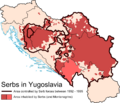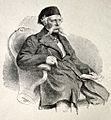Serbs facts for kids
| Total population | |
|---|---|
| ~12-13 million | |
| Regions with significant populations | |
| Former Yugoslavia | 8,200,000+ |
| ~6,200,000 (2012) | |
| ~1,300,000 (2012) | |
| 265,895 (Native Serbian speakers)(2011) | |
| ~200,000 (2011) | |
| ~40,000 (2002) | |
| ~40,000 (2002) | |
| Europe | 2,000,000+ |
| ~800,000 (2012) | |
| ~400,000 (2012) | |
| ~200,000 | |
| ~120,000 (2012) | |
| ~55,000 (2004) | |
| ~120,000 (2008) | |
| ~70,000 (2005) | |
| ~20,000 (2002) | |
| ~40,000 (2008) | |
| ~12,000 (2006) | |
| ~60,000 (2008) | |
| ~15,000 (2001) | |
| ~7,000 | |
| ~5,000 (2008) | |
| North America | 1,200,000+ |
| ~1,000,000 | |
| 80,320 (2011) | |
| Other | unknown |
| ~130,000 | |
| ~15,000 | |
| ~4,000 | |
| ~4,000 (2002) | |
| Languages | |
| Serbian | |
| Religion | |
| Predominantly Serbian Orthodox Christian | |
| Related ethnic groups | |
| Other Slavic peoples, especially South Slavs | |
Serbs (Serbian: Срби, Srbi) are a South Slavic people living in the Balkans and Central Europe, mainly in Serbia, Montenegro, Bosnia-Herzegovina, and in Croatia, in Krajina region.
Images for kids
-
Nemanjić dynasty members, the most important dynasty of Serbia in the Middle Ages
-
Serbs in the former Yugoslavia, during the Yugoslav wars
-
Vuk Karadžić, reformer of modern Serbian, which is the only European language whose speakers are fully digraphic, using both Cyrillic and Latin alphabets.
-
The national instrument gusle placed on Pirot carpet
-
Many Serb names/surnames are derived from the word wolf, which is the national animal and an important part of the national mythology.
-
Slava, a family feast in honor of its patron saint.
-
A typical Serbian Christmas meal that includes roasted pork, Russian salad and red wine.
See also
 In Spanish: Serbios para niños
In Spanish: Serbios para niños













